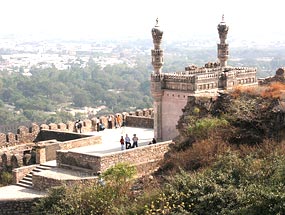Golconda Fort is a majestic monument situated
near the Hyderabad city. This article will throw more light on
Golconda Fort of India.
Golconda Fort

Location: Hyderabad, Andhra Pradesh
Founded By: Mohammed Quli Qutub Shah
Founded In: 16th century
Golconda Fort is a magnificent monument, situated on the western
periphery of the Hyderabad city. The fort was built under the patronage
of Mohammed Quli Qutub Shah, in the year 1525. The culture as well as
splendor of the Nawabs is truly reflected in the architectural style of
the Golconda Fort. Since the fort was built with infallible defenses,
its architecture is considered to be military in its style. In the
entire history of Golconda fort, it has never been known to fall to
enemy attack.
The colossal battlements, fortresses and gateways of Golconda Fort make
it one of the most defensive and impenetrable strongholds of its time.
It is situated atop a jagged terrain, which is scattered with rocks and
stones. The aural features of the fort also highlight the fact that the
builders of that time were technically quite advanced. The waterworks
seen inside as well as below the premises of the fort further stand as a
testimony to the architectural skill of the Qutab Shahi rulers. The
water needs of the people living in the Golconda Fort were met through a
maze of clay pipes fed by Persian wheels, located below the fort.
Golconda fort was initially built by the Kakatiya rulers as a mud fort,
named Mangalawaram or Mankal, in the year 1143. However, the fort
assumed its present shape when Quli Qutub Shah founded the kingdom of
Golconda and turned it into a strong fortress. Much later, Naya Quila
(an irregular rhombus with a rough pentagon) was added to the fort, on
its northeastern side. The rugged terrain, the huge boulders and the
eerie ambience surrounding the fort lend it a mystical charm.
The walls of the Golconda Fort are approximately four miles in
circumference and comprise a total of 87 semi-circular bastions inside
them. Apart from that, there are eight gateways and four drawbridges
forming the interiors of the fort. In the year 1687, Mughal Emperor
Aurangzeb invaded the fort and left it almost completely in ruins.
However, one can still see some of the huge cannons mounted at a few
points. Golconda Fort is basically made up of four distinct forts that
have been joined together.
The lowest structure of the fort is its outermost enclosure, which is
entered through the Fateh Darwaza or the Victory Gate, situated near the
southeastern corner. The gate was so named after Emperor Aurangzeb
succeeded in invading the fort and bringing it to ruins. It is known for
its magnificent architecture and amazing acoustics. This fort comprises
of a number of building inside its complex, including noble's mansions,
bazaars, temples, mosques, soldiers' barracks, stables, etc.
Amongst the numerous imposing gateways of the Golconda fort, the most
impressive one is the Fateh Darwaza. The darwaza, also known as victory
gate, is an architectural beauty and is quite famous for its amazing
acoustics. The fortresses of Golconda still house the canons that were
once used by the Qutab Shahis as well as those of the Mughal forces. A
canon, known as Fateh Rahbir (guide to victory), was boarded on Pethla
Burj by Emperor Aurangzeb and reminds the people of his resolve to
conquer Golconda.
One of the most magnificent as well as the most popular structures in
the Golconda fort is the Balahisar Darwaza. The gateway stand adorned
with statues of mythical beasts and lions, which seem to be guarding it.
From Balahisar, one has to climb almost 380 uneven stone steps to reach
the inner complex. The main complex of the fort is made up of a series
of structures, ranging from those used for public audiences to the ones
used as royal residences and halls. On the right hand side of the porch
are mortuary baths.
These baths were meant for giving ritualistic bath to the deceased
harem ladies. Then, we have the ruined Nagina Bagh, situated within an
enclosed area. As you move further, you will come across offices of
Akanna and Madanna, two important Hindu officials of Qutab Shah. Near
the upper entrance are the ruins of Ambar Khana, along with those of
Bari Baoli (step well). Then, there is a Hindu temple, belonging to the
Kakatiya period and dedicated to Goddess Kali, which was carved out of a
single huge boulder.
The mosque built by Taramati and a temple, Ram Mandir, are the other
important buildings situated within the Golconda fort. To reach the
zenana palaces (residence of women), one has to climb down a series of
narrow steps. Built on huge platforms, the palaces have been adorned
with high ceilings, decorative niches, alcoves and cornices, etc.
Graceful ornamentation on stucco adds to the splendor of the delicate
arabesques in the roundels above the side arches.
The Sound and Light Show
One of the most popular attractions of the Golconda Fort is a sound and
light show, held on a daily basis, except Monday. Audio and visual
effects are used to display the entire story of the Golconda Fort before
the audience. The show is presented in three languages, English, Hindi
and Telugu.
Show Timings
Winters (November to February) - 6:30pm
Summers (March to October) - 7:00pm
In English: Wednesday and Sunday
In Hindi: Tuesday, Friday and Saturday
In Telugu: Thursday


